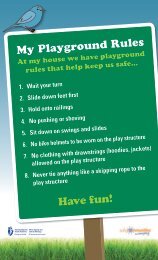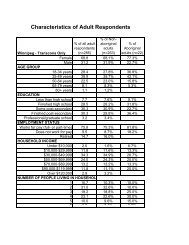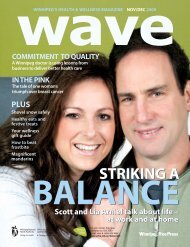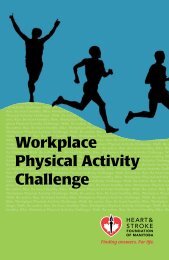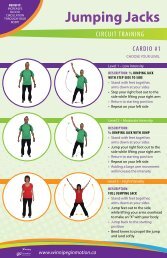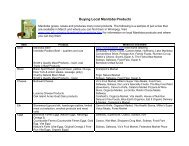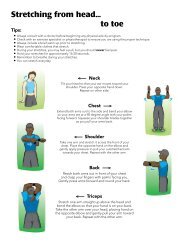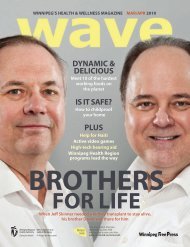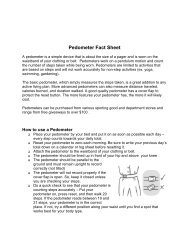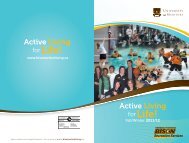Wave: Fall 2009 - Winnipeg Regional Health Authority
Wave: Fall 2009 - Winnipeg Regional Health Authority
Wave: Fall 2009 - Winnipeg Regional Health Authority
- No tags were found...
Create successful ePaper yourself
Turn your PDF publications into a flip-book with our unique Google optimized e-Paper software.
lunch. Their mother, Lori McCubbin, makessure that Kyra, Scott and middle child Spencer,15, get off to a good start in the morning.The breakfast menu usually consists ofcereal, milk, eggs, waffles, yogurt and fruit.And then there is dinner – selections caninclude meat, vegetables and pasta.In addition to eating healthy foods, thekids also try to avoid eating less healthyfoods. Junk food is limited, although therehave been some breakdowns in that department,acknowledges Lori – the boys dohave a soft spot for Slurpees. “As they getolder, and start to make a little money, theycan buy anything they want to eat,” shesays with a rueful shake of her head. “I’mtrying to let them know what good food isnow, so they won’t fill up on junk whenthey grow up,” she adds.Bottom line: The McCubbin kids aremaking good food choices that shouldhelp them maintain their overall healthand well-being. But can their diet also helpthem become more successful at school?The answer, according to Lorna Shaw-Hoeppner, a community nutritionist withthe <strong>Winnipeg</strong> <strong>Health</strong> Region’s ACCESSRiver East health centre, is yes. An increasingnumber of studies are indicating thatwhat kids eat can have a positive impacton their grades, as well as their physicaland social development – the three mainingredients to a successful school year.Moreover, says Shaw-Hoeppner, studiesalso show that being undernourished cando just the opposite.For example, the Children’s Lifestyleand School-performance Study (CLASS) inNova Scotia looked at the performance of5,000 fifth graders. It found that those withthe best diet quality did better, regardlessof other factors. They used an indexto measure diet quality based on a fewthings, including adequacy, balance, fruitand vegetable intake. “We demonstratedthat above and beyond socioeconomic factors,diet quality is important to academicperformance,” according to Paul Veugelers,one of the study’s authors. With kids of allages now back at school this fall, that researchis providing some food for thought.When it comes to eating their way toa better school year, the McCubbin kidsappear to be nibbling in the right direction,says Shaw-Hoeppner. That’s because they’rechoosing fruits, vegetables, whole grains,seafood and pastas – foods that containprotein and carbohydrates that power thebody and boost the brain. And they’re alsoAs for lunch, schools are increasingly changing menusand improving the nutritional value of food offered in theircafeterias and vending machines. The WSD adopted anutrition policy in 2007 that stopped the selling of pop,chocolate bars and chips in vending machines, and supportseducation about proper nutrition in physical educationand health education classes. WSD cafeterias now sellwater, milk and fruit juices, but not pop or junk food. Highschool cafeterias have guidelines that restrict fast food,such as french fries and hamburgers, so these are servedless frequently.community and the foods that represent the cultures. Forexample, one school may have bannock and wild rice onthe menu, and another may have spicy African or Caribbeanfoods.”Other school districts throughout the province follow a similarjunk food ban, following provincial guidelines to counteractrising rates of obesity and other health problems inchildren.“The food is reasonably priced, and includes items suchas soups, salads and sandwiches,” says Tighe. She citedGordon Bell High School as an example of the division’sfood policy in action, noting the cafeteria offers nutritious,inexpensive meals with a nod to the many ethnicities thatmake up the student population. “Schools look to their<strong>Fall</strong> <strong>2009</strong> 15



